Dinner With Churchill: Policy-Making at the Dinner Table (22 page)
Read Dinner With Churchill: Policy-Making at the Dinner Table Online
Authors: Cita Stelzer
Tags: #General, #Biography & Autobiography, #Military, #History, #World War II, #20th Century, #Europe, #World, #International Relations, #Historical, #Political Science, #Great Britain, #Modern, #Cooking, #Entertaining

The Prime Minister also much enjoyed Château Yquem, which Victor Rothschild served at a dinner party at the Savoy in 1944 to lighten Churchill’s “dark” mood when the evening brought news of the grave difficulties being encountered at the Anzio beachhead.
58
Lady Williams told the author that Churchill did not care much for other Sauternes and sweet wines, preferring brandy after dinner.
It is reported that the Savoy provided a bedroom for the famous Churchillian after-lunch naps, taking good care of a treasured guest.
59
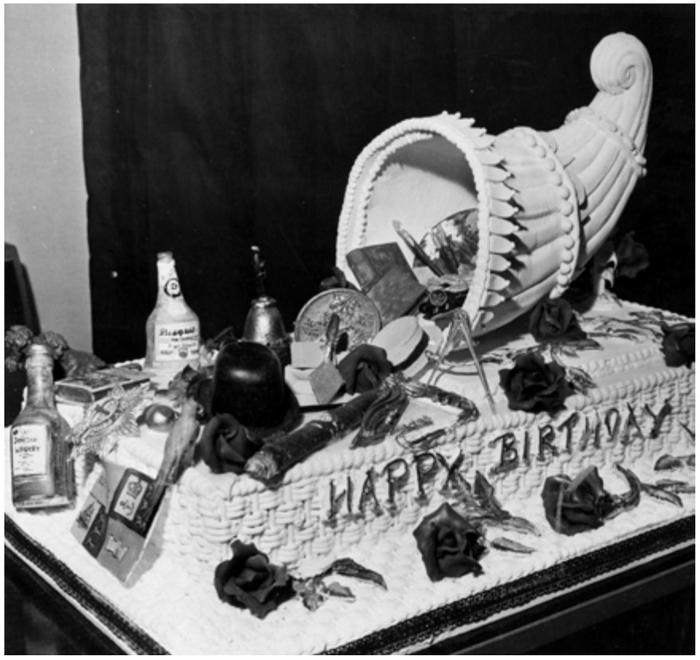
Cornucopia at 86
Churchill could be humorous about his drinking. In 1943, after the Casablanca meeting, he wrote to Harry Hopkins
about a dinner at the “White House”, as Roosevelt’s villa there was called: “Dinner at the White House (dry, alas!); with the Sultan … After dinner, recovery from the effects of the above”.
60
On Churchill’s 86th birthday, a wise bakery presented Churchill with a cake in the shape of a
cornucopia
, with tiny whisky and champagne bottles pouring from its mouth.
Churchill was generous with his wines. He told his
life-long
friend, Violet Bonham Carter: “There has never been a day in my life when I could not order a bottle of champagne for myself and offer another to a friend.”
61
In the early 1960s, he was engaged in correspondence with Emery and Wendy Reves, his frequent hosts in the South of France, at their
villa
, La Pausa, concerning the disposition of the “12 bottles of champagne Madame Pol Roger sent you”. Reves was
forbidden
by British customs regulations from shipping them to Churchill, who had already returned to Britain. Churchill advised Reves to hold onto the champagne until his next visit and to “make use of it yourselves in the interim”.
62
Six rooms from La Pausa are today recreated at the Dallas Museum of Art. The dining room is set as it would have been when Churchill dined there with friends, including, among others, Field Marshal Montgomery, Aristotle Onassis, Lord Cherwell and Noel Coward. The splendid collection of more than 1,400 French impressionist paintings that hung at La Pausa are now in Dallas.
Churchill was also generous with his wines at parties and dinners. Mrs. Churchill was away when he gave a summer cocktail party at Chartwell, but she heard that”32 bottles of champagne were consumed among 32 people. I hope the tasty
tit-bits made by Mrs. Landemare were also appreciated.”
63
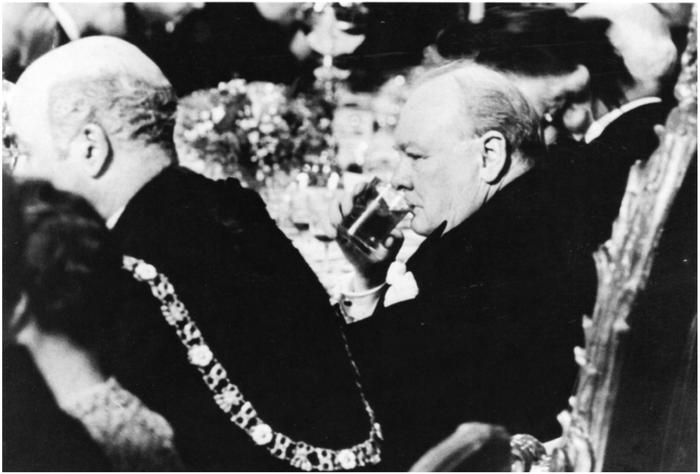
A weak whisky and soda at Mansion House
Two things seem clear about Churchill’s relationship with alcohol. His use of spirits differed little from that of
members
of his class: Victor Rothschild, working for the security service MI5 during the Second World War, eased the heavy burdens of long days at the office by dipping into an open bottle of champagne kept on his desk.
64
Second, Churchill enjoyed his various drinks, and felt they added to the
conviviality
of his dinner parties. But he never allowed drink to impair his judgment. One of Churchill’s most famous quips seems to have been true – that he had taken more out of
alcohol
than it had taken out of him. That, after all, is what matters.
1
. Moir, p 138
2
. Churchill, Winston S.,
My Early Life: A Roving Commission
, p. 125
3
. Churchill, Randolph S.,
Winston S. Churchill, Youth, 1874-1900
, Volume I, p. 453
4
. Philip and Susan Larson, “Winston S. Churchill and Robert R. McCormick,”
Finest Hour
, 131, p. 33
5
. McJimsey, George,
Harry Hopkins: Ally of the Poor and Defender of Democracy
. P. 140 refers to the “prodigious quantities of weak whiskey” that Churchill consumed during Hopkins’ 1941 visit to Britain.
6
. Churchill, Winston S.,
My Early Life: A Roving Commission
, p. 125
7
. CHAR 1/400A/46
8
. Tugwell, Rexford G.,
The Democratic Roosevelt
, p. 593
9
. Sherwood, Robert E., p. 442
10
. Butcher, Captain Harry C.,
My Three Years With Eisenhower
, p. 75
11
. Skidelsky, Vol. 3, p. 92
12
.
Finest Hour
, 131, p. 35
13
. King, Mackenzie, Diary, 23 August 1941, from
www.collectionscanada.gc.ca
, p. 879
14
. Kimball, Warren F.,
Forged in War: Roosevelt Churchill and the Second World War
, p. 22
15
. Reilly, Michael F., as told to William J.
Slocum, Reilly of the White House
, p. 125
16
. Gilbert, Martin,
In Search of Churchill
, p. 209
17
. Wilson, A.N.,
After The Victorians
, p. 390
18
. Moran, p. 390
19
. Roberts, Andrew,
Eminent Churchillians
, p. 170
20
. Harvey, John (ed.),
The War Diaries of Oliver Harvey, 1941-1945
, p. 369
21
. Nevezhin, Vladimir A., in a collection of “Stalin’s Table Speeches”, Moscow: AIRO-XX, 2003
22
. Gilbert, Volume VII p. 191
23
. Moran, p. 59
24
. Gilbert, Volume VII, p. 193
25
. Churchill,
The Malakand Field Force
, p. 16
26
. Kimball, Warren F., “Like Goldfish in a Bowl: The Alcohol Quotient”,
Finest Hour
, 134, p. 32
27
. James, Robert Rhodes,
Churchill: A Study in Failure
, p. 389
28
. Danchev and Todman (eds.), p. 566
29
. Harmon, Christopher C., “Alanbrooke and Churchill”, a review of the
Alanbrooke Diaries
, in Finest Hour 112, p. 34
30
. Langworth, Richard M. (ed.),
Churchill by Himself
, p. 550. (Langworth says that Churchill was paraphrasing a W.C. Fields retort.)
31
. Acheson, Dean,
Sketches From Life Of Men I have Known
, p. 66. John Martin tells this same story taking place on 3 August 1941 on the train north when Churchill was on the way to meet with President Roosevelt in Newfoundland. Martin p. 56
32
. Beschloss, p. 135
33
. Letter from Jo Sturdee, later, Countess of Onslow, to her family from La Mamounia Hotel, Marrakesh, Morocco, 7 January 7 1948, to her family. ONSL 1
34
. Louanne Cox, www.helium.com, February 2011.
35
. CHUR 1/15/32 and 33
36
. Gilbert, Volume VI, p. 336 note 1
37
. Gilbert, Martin,
In Search of Churchill
, p. 209
38
. Williams, Jane, conversations with author
39
. Eden,
The Reckoning
, p. 494
40
.
Finest Hour
144, “The Churchill Quiz”, p. 63
41
. Churchill, Randolph S., p .453
42
. Langworth (ed.),
Churchill by Himself
, p. 37
43
. Acheson, p. 64
44
. Ray, Jonathan, “Winston Churchill drank Pol Roger by the Pint”,
Telegraph
, 30 September 2006
45
.
Telegraph
, Odette Pol Roger, 30 December 2000
46
. Roberts, Andrew,
The Holy Fox: A Life of Lord Halifax
, p. 186
47
. Churchill,
My Early Life
, p. 178
48
. McGowan, p. 90
49
. Rose, Kenneth,
The Elusive Rothschild, The Life of Victor, Third Baron
, p. 58
50
.
Telegraph
, Odette Pol Roger, 30 December 2000
51
.
Independent
, Odette Pol Roger, 30 January 2001
52
. www.polroger.co.uk
53
.
Ibid
.
54
.
Ibid
.
55
. Dilks (ed.),
Cadogan
, p. 707
56
. McGowan, p. 104
57
. Kersaudy, Francois,
Churchill et Monaco
, p. 46
58
. Rose, p. 73
59
. McGowan, p. 55
60
. Kimball, Warren,
Finest Hour
134, p. 31
61
. Bonham Carter, p. 135
62
. Gilbert (ed.),
Winston Churchill and Emery Reves: Correspondence, 1937-1964
, pp. 376-377
63
. Gilbert, Volume VIII, p 630
64
. Rose, p. 53
“As we got up from the table, his cigar was going like a steam locomotive on a stiff grade.”
1
N
o discussion about Churchill at dinner would be complete without mention of his ever-present cigar. Churchill probably would have smoked vast quantities of them if he had never entered public life: they were one of his great pleasures. But they served two other purposes:
prolonging
the after-dinner discussions at which he shone, and serving as his political symbol.
Churchill fell in love with cigars in 1895, when he visited Cuba as a 21-year-old reporter for the
Daily Graphic
,
covering
the island’s eventually successful war for independence from Spain. He smoked his first Havanas then, and as Larry
Arnn, a Churchill scholar, has said: “Thereafter, cigar and Cuban were synonymous for Churchill.”
2
He had been a heavy cigarette smoker while at Sandhurst, where his father, Lord Randolph Churchill, provided him with boxes of his own best cigarettes. At the turn of the century, his mother asked J.J. Fox Cigar Shop, St James’s, to open an account in her son’s name. Thereafter he often ordered her favourite gold-tipped handmade Turkish cigarettes for her when
placing
an order for himself.
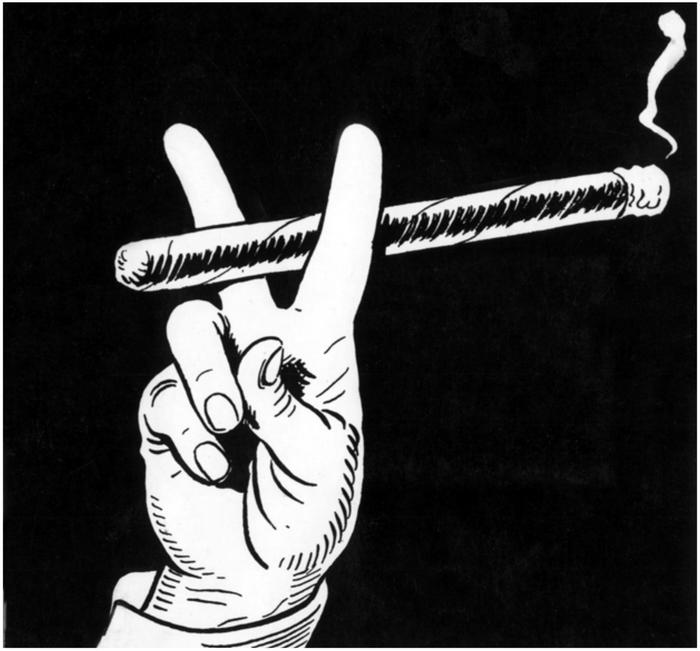
Victory symbol
Lord Randolph, who encouraged his son’s cigarette
smoking
, heartily disapproved of his cigar smoking. In response to that disapproval, the young subaltern made what must
have been one of the worst predictions of his life: “I don’t think I shall often smoke more than one or two a day – and very rarely that.”
3
He later took the same line when
responding
to his gastroenterologist, Dr. Hunt, who had recommended “Cigars – to use a holder and reduce the number.” Churchill responded: “… numbers [of cigars] will, I trust, be reduced”.
4
No indication of by whom – an odd or
purposefully
vague sentence structure for so punctilious a writer as Churchill, suggesting the lack of a deep commitment to smoking less.
His father and his doctor notwithstanding, records at Fox of St. James’s, his principal supplier from 1900 until his death, show orders often in the hundreds. Even allowing for the consumption of his dinner guests, the quantities ordered indicate massive consumption and made Churchill one of Fox’s better customers.
Once he discovered fine Havanas, neither age nor
infirmity
diminished his enthusiasm for cigars. In early 1943 he was taken seriously ill with pneumonia but, according to his doctors, continued to smoke. Some twenty years later, when recovering from a broken hip and again warned by his
doctors
against smoking, Churchill continued defiantly to puff away.
5
Neither the broken hip nor the several strokes he
suffered
(the most serious in 1953, when he was briefly
paralysed
) deterred him from indulging his habit.
As time passed, and Churchill’s fame spread, he realised that his cigar had become a symbol, as important a part of his image as the jaunty Camel cigarette and holder later
became
for Franklin D. Roosevelt. As early as 1904, one of his wartime biographers wrote: “The cartoonists lent their
services
, and already the famous lineaments were beginning to take shape, the squat form, the perpetual cigar”.
6
Many wartime cartoons show Churchill as the British bulldog, often puffing on a cigar. He clearly felt that the
cigar
helped convey his determination to win the war and his confidence that Britain would prevail. Dean Acheson would later sum up Churchill: “Everything felt the touch of his art – his appearance and gestures, the siren suit, the indomitable V sign for victory, the cigar for imperturbability.”
7
Churchill rarely smoked cigars to the end. His valet, Norman McGowan, reported that he never saw him finish a cigar. He habitually left about half in the ashtray, and
ordered
that all of those half-smoked cigars be turned over to his gardener for use as pipe tobacco.
8
Roy Howells, however, who also cared for Churchill during the last years of his life, noted that he did at times, in those last years, smoke cigars to the end. McGowan calculates that Churchill smoked nine or so cigars a day. Smoked to the end or only partially, that is a lot of fine tobacco, even by the standards of a time in which cigar smoking was not impeded by the restrictions we live with today.
9
Churchill’s love of cigars was so well known that it
produced
a substantial flow of gifts from admirers all over the world. This flow was not one way: Churchill delighted in sharing his taste with others, although he was careful not to introduce his grandson, Winston, to his own preference for only the best. Churchill directed Robert Lewis (the firm later acquired by J.J. Fox) to send a box of cigars to his grandson on the occasion of his birthday. They were to be “of good quality, but not quite as good as the Romeo & Juliet, and of medium size”.
10
Churchill could sometimes be generous with his cigars as he was with his champagnes, but not overly so. In 1949, when his inventory included a large cache of Jamaican cigars, he
upbraided his butler for offering guests some of his finest Cubans, which he preferred to keep for himself.
11
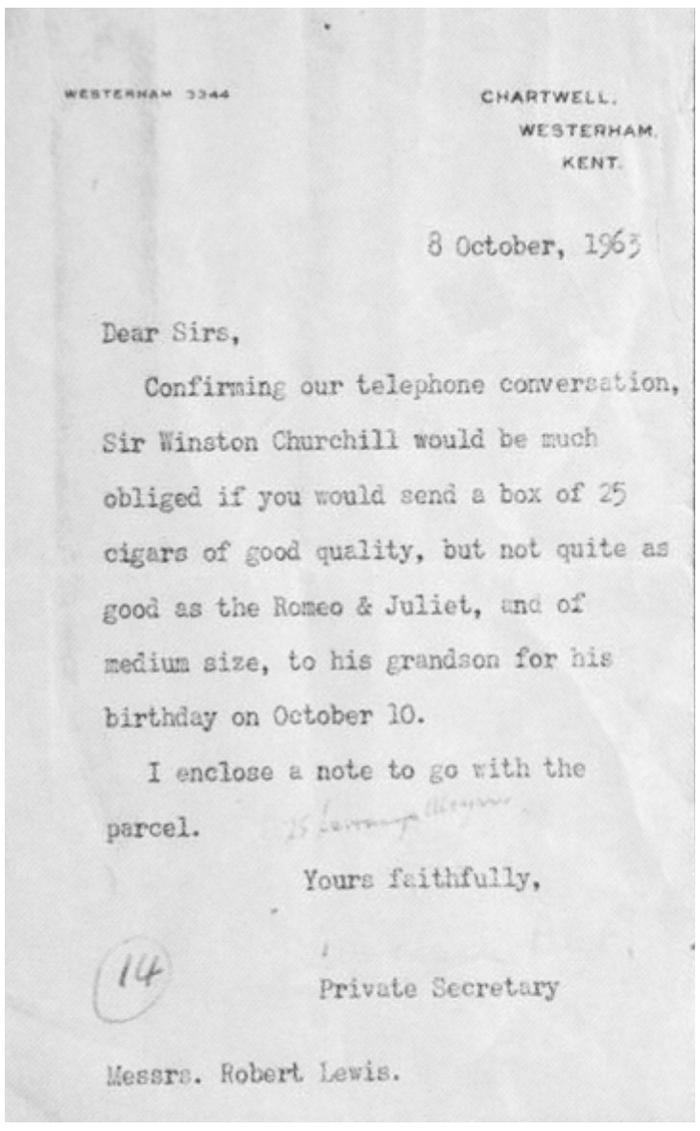
Don’t want to spoil the boy
Like all devoted cigar smokers, Churchill developed his own quirks and rituals. His pilot during the First World War, Lieutenant Gilbert Hall, described Churchill holding his
cigar
between his first finger and his thumb while leisurely rolling it across the top of his coffee cup.
12
He invented what he called “bellybandoes”. He would light a candle in order to warm the tip of his cigar, “next he lovingly wrapped a piece of gummed brown paper around the other end”, so that “it stopped the end from becoming too wet when I chew it’”. He was proud of his invention and bragged: “I designed
that myself.”
13
Whether he realised it or not, his
bellybandoes
limited direct contact with the tobacco and hence his intake of nicotine.
14
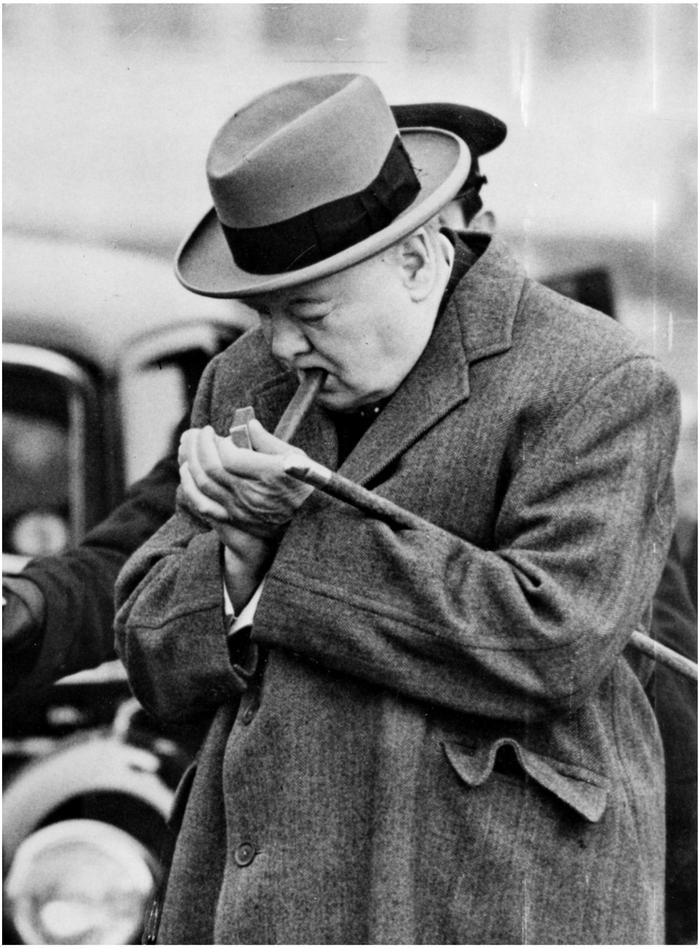
Firing up
In 1936, Dr Hunt had recommended that Churchill reduce the number of cigars smoked (advice unheeded as we have seen) and that he use a cigar holder (advice heeded perhaps by inventing the bellybando).
15
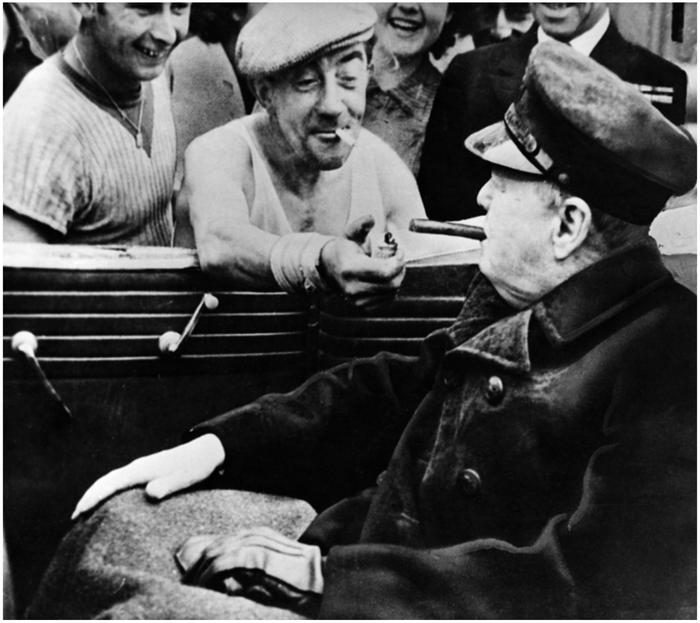
Merci for the light, at Cherbourg, 1944
Churchill was as fussy about the matches he used as he was
about his cigars. He preferred long matches, long enough to remain lit after the sulphur had burned off so that the odour could not contaminate the aroma and taste of the cigar. He favoured two-inch long cedar matches specially flown over in large cartons from Canada.
16
These he used not only to light his Havanas, but also to pierce the end, ignoring the piercer on his watch chain and the elaborate cutters that he received among the many cigar-related gifts.
17
Emery Reves, Churchill’s literary agent and a generous host, gave him a silver pagoda-shaped ashtray with a trough on top to hold his cigar,
18
a gift that became Churchill’s favourite cigar accessory.
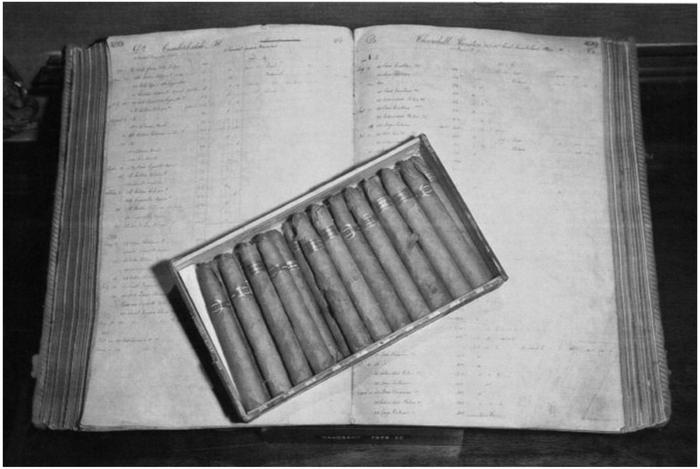
Some of my favourite things from Fox Cigar Shop
Churchill’s preferred smoke in the 1930s was the Royal Derby Longfellow, but a 23 January 1949 inventory of his stock at Chartwell, which totalled between 3,000 and 4,000
cigars, reveals a range of brands. His favourites were Romeo y Julieta, a box of which survives (barely) in the Fox Churchill Museum that his tobacconist has created in St. James’s, and the no-longer-made La Aroma de Cuba.
19
Churchill preferred these and other large Havanas, as his hosts at the Casablanca Conference learned when he quite surprisingly ran out of cigars. The best that his American hosts could then produce was a box of five-cent White Owls. After removing the price, the Americans presented them to him. That night, FDR’s Chief of Staff, General George C. Marshall, commented “that the prime minister must be
giving
up smoking. He usually smoked three or four cigars at a session, but that day he took one or two puffs on a cigar and put it out”.
20

